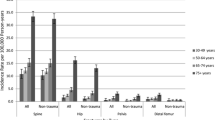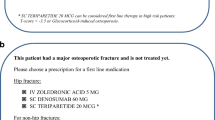Abstract
Summary
A simple case definition for osteoporosis case diagnosis is feasible based upon administrative health data. This may facilitate implementation of a population-based osteoporosis surveillance program, providing information that could help to inform and guide screening, prevention, and treatment resources.
Introduction
Our aim was to construct and validate a simplified algorithm for osteoporosis case ascertainment from administrative databases that would be suitable for disease surveillance.
Methods
Multiple classification rules were applied to different sets of hospital diagnosis, physician claims diagnosis, and prescription drug variables from Manitoba, Canada. Algorithms were validated against results from a regional bone mineral density testing program that identified bone mineral density (BMD) measurements in 4,015 women age 50 years and older with at least one BMD test between April 1, 2000 and March 31, 2001.
Results
Sensitivity as high as 93.3% was achieved with 3 years of data. Specificity ranged from 50.8% to 91.4% overall, and from 81.2% to 99.1% for discriminating osteoporotic from normal BMD. Sensitivity and overall accuracy were generally lower for algorithms based on diagnosis codes alone than for algorithms that included osteoporosis prescriptions. In the subgroup without prior osteoporotic fractures or chronic corticosteroid use, one simple algorithm (one hospital diagnosis, physician claims diagnosis, or osteoporosis prescription within 1 year) gave accuracy measures exceeding 90% for discriminating osteoporosis from normal BMD across a wide range of disease prevalence.
Conclusions
A relatively simple case definition for osteoporosis surveillance based upon administrative health data can achieve an acceptable level of sensitivity, specificity, and accuracy. Performance is enhanced when the case definition includes osteoporosis medication use in the formulation.

Similar content being viewed by others
References
Johnell O, Kanis JA, Oden A et al (2004) Mortality after osteoporotic fractures. Osteoporos Int 15:38–42
Adachi JD, Ioannidis G, Berger C et al (2001) The influence of osteoporotic fractures on health-related quality of life in community-dwelling men and women across Canada. Osteoporos Int 12:903–908
Lips P, van Schoor NM (2005) Quality of life in patients with osteoporosis. Osteoporos Int 16:447–455
Brown JP, Josse RG (2002) 2002 clinical practice guidelines for the diagnosis and management of osteoporosis in Canada. CMAJ 167:S1–S34
Papadimitropoulos EA, Coyte PC, Josse RG et al (1997) Current and projected rates of hip fracture in Canada. CMAJ 157:1357–1363
Jaglal SB, McIsaac WJ, Hawker G et al (2000) Patterns of use of the bone mineral density test in Ontario, 1992–1998. CMAJ 163:1139–1143
Lu Y, Genant HK, Shepherd J et al (2001) Classification of osteoporosis based on bone mineral densities. J Bone Miner Res 16:901–910
Tenenhouse A, Joseph L, Kreiger N et al (2000) Estimation of the prevalence of low bone density in Canadian women and men using a population-specific DXA reference standard: the Canadian Multicentre Osteoporosis Study (CaMos). Osteoporos Int 11:897–904
Vestergaard P, Rejnmark L, Mosekilde L (2005) Osteoporosis is markedly underdiagnosed: a nationwide study from Denmark. Osteoporos Int 16:134–141
Yang NP, Deng CY, Chou YJ et al (2006) Estimated prevalence of osteoporosis from a Nationwide Health Insurance database in Taiwan. Health Policy 75:329–337
Sanders KM, Seeman E, Ugoni AM et al (1999) Age- and gender-specific rate of fractures in Australia: a population-based study. Osteoporos Int 10:240–247
Burge RT, King AB, Balda E et al (2003) Methodology for estimating current and future burden of osteoporosis in state populations: application to Florida in 2000 through 2025. Value Health 6:574–583
Goettsch WG, de Jong RB, Kramarz P et al (2007) Developments of the incidence of osteoporosis in The Netherlands: a PHARMO study. Pharmacoepidemiol Drug Saf 16:166–172
Lippuner K, Golder M, Greiner R (2005) Epidemiology and direct medical costs of osteoporotic fractures in men and women in Switzerland. Osteoporos Int 16(Suppl 2):S8–S17
Bernstein CN, Blanchard JF, Rawsthorne P et al (1999) Epidemiology of Crohn's disease and ulcerative colitis in a central Canadian province: a population-based study. Am J Epidemiol 149:916–924
Hux JE, Ivis F, Flintoft V et al (2002) Diabetes in Ontario: determination of prevalence and incidence using a validated administrative data algorithm. Diabetes Care 25:512–516
Svenson LW (1991) Regional disparities in the annual prevalence rates of Parkinson's disease in Canada. Neuroepidemiology 10:205–210
Blanchard JF, Ludwig S, Wajda A et al (1996) Incidence and prevalence of diabetes in Manitoba, 1986–1991. Diabetes Care 19:807–811
Fowles JB, Fowler EJ, Craft C (1998) Validation of claims diagnoses and self-reported conditions compared with medical records for selected chronic diseases. J Ambul Care Manage 21:24–34
Rector TS, Wickstrom SL, Shah M et al (2004) Specificity and sensitivity of claims-based algorithms for identifying members of Medicare plus Choice health plans that have chronic medical conditions. Health Serv Res 39:1839–+
Robinson JR, Young TK, Roos LL et al (1997) Estimating the burden of disease. Comparing administrative data and self-reports. Med Care 35:932–947
Saydah SH, Geiss LS, Tierney E et al (2004) Review of the performance of methods to identify diabetes cases among vital statistics, administrative, and survey data. Ann Epidemiol 14:507–516
Wilchesky M, Tamblyn RM, Huang A (2004) Validation of diagnostic codes within medical services claims. J Clin Epidemiol 57:131–141
Tu K, Campbell NRC, Chen Z-L et al (2007) Accuracy of administrative databases in identifying patients with hypertension. Open Medicine 1:E3–E5
Maio V, Yuen E, Rabinowitz C et al (2005) Using pharmacy data to identify those with chronic conditions in Emilia Romagna, Italy. J Health Serv Res Policy 10:232–238
Statistics Canada (2008) 2006 Statistics Canada census highlights. Statistics Canada Last accessed: Dec. 18, 2008. URL: http://www12.statcan.ca/census-recensement/2006/dp-pd/index-eng.cfm
Roos NP (1999) Establishing a population data-based policy unit. Med Care 37:JS15–JS26
Watson DE, Katz A, Reid RJ et al (2004) Family physician workloads and access to care in Winnipeg: 1991 to 2001. CMAJ 171:339–342
Leslie WD, Metge C (2003) Establishing a regional bone density program: lessons from the Manitoba experience. J Clin Densitom 6:275–282
Leslie WD, Caetano PA, MacWilliam LR et al (2005) Construction and validation of a population-based bone densitometry database. J Clin Densitom 8:25–30
Hansen KE, Binkley N, Christian R et al (2005) Interobserver reproducibility of criteria for vertebral body exclusion. J Bone Miner Res 20:501–508
Kanis JA, Melton LJ III, Christiansen C et al (1994) The diagnosis of osteoporosis. J Bone Miner Res 9:1137–1141
Leslie WD, Adler RA, El-Hajj FG et al (2006) Application of the 1994 WHO classification to populations other than postmenopausal Caucasian women: the 2005 ISCD official positions. J Clin Densitom 9:22–30
Lewiecki EM, Watts NB, McClung MR et al (2004) Official positions of the international society for clinical densitometry. J Clin Endocrinol Metab 89:3651–3655
Siminoski K, Leslie WD, Frame H et al (2007) Recommendations for bone mineral density reporting in Canada: a shift to absolute fracture risk assessment. J Clin Densitom 10:120–123
Binkley N, Kiebzak GM, Lewiecki EM et al (2005) Recalculation of the NHANES database SD improves T-score agreement and reduces osteoporosis prevalence. J Bone Miner Res 20:195–201
Leslie WD, Caetano PA, Roe EB (2005) The impact of hip subregion reference data on osteoporosis diagnosis. Osteoporos Int 16:1669–1674
Leslie WD (2006) The importance of spectrum bias on bone density monitoring in clinical practice. Bone 39:361–368
Brown JP, Josse RG (2002) 2002 clinical practice guidelines for the diagnosis and management of osteoporosis in Canada. CMAJ 167:S1–S34
Sackett DHR, Haynes RB, Guyatt G, Tugwell P (eds) (1991) Clinical epidemiology: a basic science for clinical medicine. Little, Brown and Company, Boston
Leslie WD, Siminoski K, Brown JP (2007) Comparative effects of densitometric and absolute fracture risk classification systems on projected intervention rates in postmenopausal women. J Clin Densitom 10:124–131
Cranney A, Tsang JF, Leslie WD (2008) Factors predicting osteoporosis treatment initiation in a regionally based cohort. Osteoporos Int 20:1621–1625
Kanis JA, McCloskey EV, Johansson H et al (2008) A reference standard for the description of osteoporosis. Bone 42:467–475
Lix LM, Yogendran MS, Leslie WD et al (2008) Using multiple data features improved the validity of osteoporosis case ascertainment from administrative databases. J Clin Epidemiol 61:1250–1260
Acknowledgments
This research was supported by grants from the Canadian Institutes of Health Research, the Surveillance Division of the Centre for Chronic Disease Prevention and Control at the Public Health Agency of Canada, and by a Canadian Institutes of Health Research New Investigator Award. The authors are indebted to Manitoba Health & Healthy Living for the provision of data (HIPC File No. 2005/2006-32). The results and conclusions are those of the authors, and no official endorsement by Manitoba Health & Health Living is intended or should be inferred. This article has been reviewed and approved by the members of the Manitoba Bone Density Program Committee.
Conflicts of interest
William D. Leslie: honoraria for lectures: Merck Frosst Canada; research support from: Merck Frosst Canada; unrestricted educational and research grants: The Alliance for Better Bone Health—Sanofi-Aventis and Procter & Gamble Pharmaceuticals Canada, Inc., Novartis Pharmaceuticals Canada, Inc., Amgen Pharmaceuticals, Inc., Genzyme Canada Ltd. Lisa M. Lix: unrestricted research grants: Amgen Pharmaceuticals, Inc. Marina Yogendran: None.
Author information
Authors and Affiliations
Corresponding author
Rights and permissions
About this article
Cite this article
Leslie, W.D., Lix, L.M. & Yogendran, M.S. Validation of a case definition for osteoporosis disease surveillance. Osteoporos Int 22, 37–46 (2011). https://doi.org/10.1007/s00198-010-1225-2
Received:
Accepted:
Published:
Issue Date:
DOI: https://doi.org/10.1007/s00198-010-1225-2




